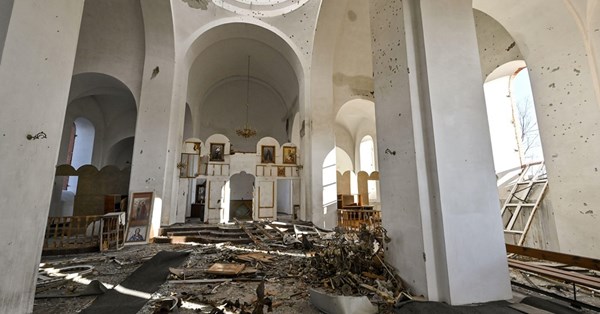RUSSIAN troops have killed 67 clerics of different denominations in Ukraine since the February 2022 invasion, the Ukrainian government has said.
“The Russian state, together with the Russian Orthodox Church, cynically ignoring the norms of international law, has implemented a system of repression against religious communities in the captured Ukrainian territories, aimed at destroying religious diversity and Ukrainian spiritual identity,” the Ukrainian Ministry of Foreign Affairs said in a statement last week.
It spoke of “systematic violations of religious freedom in the territories of Ukraine temporarily occupied by the Russian Federation”, and “barbaric Russian persecution of ordinary people” for practising their faith.
Since the war began, some religious groups in Ukrainian territories under Russian occupation have been nearly eradicated, such as the Ukrainian Greek Catholic Church and the Orthodox Church of Ukraine, while Protestant and Catholic communities have been reduced to only a few.
Of the 1967 religious congregations that existed in Luhansk, Donetsk, Zaporizhzhia, and Kherson, before the war, only 902 remain today, representing a steep decline. According to an investigation carried out by Novaya Gazeta Europe, part of the reason for the decline is also linked to “depopulation” in the occupied areas.
Novaya Gazeta Europe reports that, in several areas, the Russian Orthodox Church has been replacing the most senior Ukrainian Orthodox clergymen with Russian-born ones. There have been reports that some churches in occupied territories have been reconsecrated, after being absorbed into the Russian Orthodox Church.
The Ukrainian Ministry of Foreign Affairs reported that the Russian Orthodox Church annexed more than 1600 parishes, including 23 monasteries and eight dioceses of the Ukrainian Orthodox Church.
The director for international advocacy and research at the Ukrainian Institute for Religious Freedom, Dr Maksym Vasin, told the Church Times that Russia wanted to exert societal control in those territories through total control over religious life, and that conditions in these regions remained perilous, as the war carried on and “the front line shifts back and forth.”
“Ukrainian religious communities and their leaders who refused to collaborate with the occupying authorities — an overwhelming majority — were forced either to flee to safer regions to escape persecution, or to go underground,” he said.
“Those who remained risked forcible deportation, illegal imprisonment, torture, and even execution for continuing religious services. As a result, Russia’s regime shut down most churches and religious communities in the occupied territories of Ukraine. Some faith-based communities have effectively disappeared due to mass migration, the lack of places of worship, and the repression of their leaders.”
The invasion of Ukraine by Russia has devastated many religious sites, including those in use as bomb shelters and for displaced people and humanitarian work. The “Religion on Fire” project documents destruction and damage by Russian troops of Ukrainian religious property, as well as killings, woundings, and abductions of religious leaders. As of February 2025, it reports that 643 places of worship have been affected, including 53 buildings that have been completely destroyed, and 97 that are severely damaged.
The affected areas mainly include temporarily occupied regions and Kyiv, where the Ukrainian Orthodox Church, together with Protestant and Jehovah’s Witness congregations, has faced the most severe losses.
















